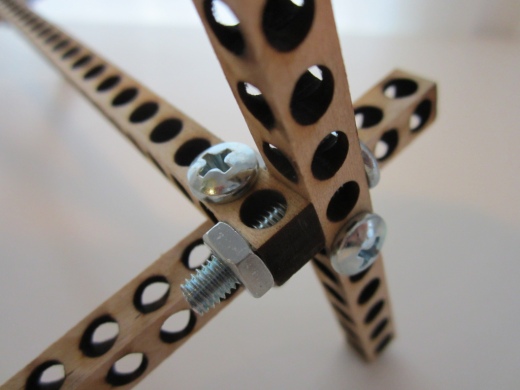What is Bitbeam?
Perspicaciously, Bitbeam is just holes in poles.
The marketing tagline would be something like this: “Bitbeam is the building toy for the Make generation.” Or perhaps: “Lego + Grid Beam = Awesome”.
Lego + Grid Beam = Huh?
Most people are already familiar with Lego. Lego Technic is a geekier version of standard Lego bricks that can be used for building more mechanical and sophisticated structures like toy cranes or robots.
Similar to Lego Technic, grid beam is a modular building technology. Unlike other building toys, however, grid beam and Bitbeam are open source hardware designs. You can make grid beam parts in your garage using simple tools like saws and drills. People use grid beam to build bigger things like real tables, beds — almost anything!
Bitbeam is a Lego Technic-compatible building technology inspired by grid beam. Bitbeam is a smaller version of grid beam made with a 3D printer. The idea is to miniaturize grid beam and make it Lego Technic compatible.
Why create Bitbeam? What’s wrong with Lego?
Nothing’s wrong! Lego is awesome stuff. I love Lego, my kids love Lego; I even proposed to my wife at Legoland! Believe me, I love Lego. However, the defining trait of this high-tech post-industrial economy we’re building here is that designers won’t (necessarily) dominate or control the means of production of the things they design. If someone wants Bitbeams, and I no longer make them, you’ll still be able to make them yourself. And you’ll have the licensed freedom to do so. Bitbeam-wanters will have the means to create beams themselves to meet demand. Open source hardware democratizes the supply chain.
The advantage of building your own Bitbeam parts over Lego is that 1) the materials are cheaper to source yourself, 2) you can make parts in sizes that Lego doesn’t make, and 3) playing with 3D printers is fun!
How is Bitbeam made?
With a 3D printer. (I used to make them with a laser cutter, but I’ve found 3D printing is easier.) First, I design a bitbeam kit in an open source design program called OpenSCAD. I then export to the STL file format, import into Slic3r, export as gcode, then send to the printer. Here are some beams printing at on my Lulzbot 3D printers in Chicago:
Bitbeam height and width is 8mm inches, and each hole is 8mm apart — just like Lego Technic. The hole size is 5.1 mm wide, also just like Lego Technic.
